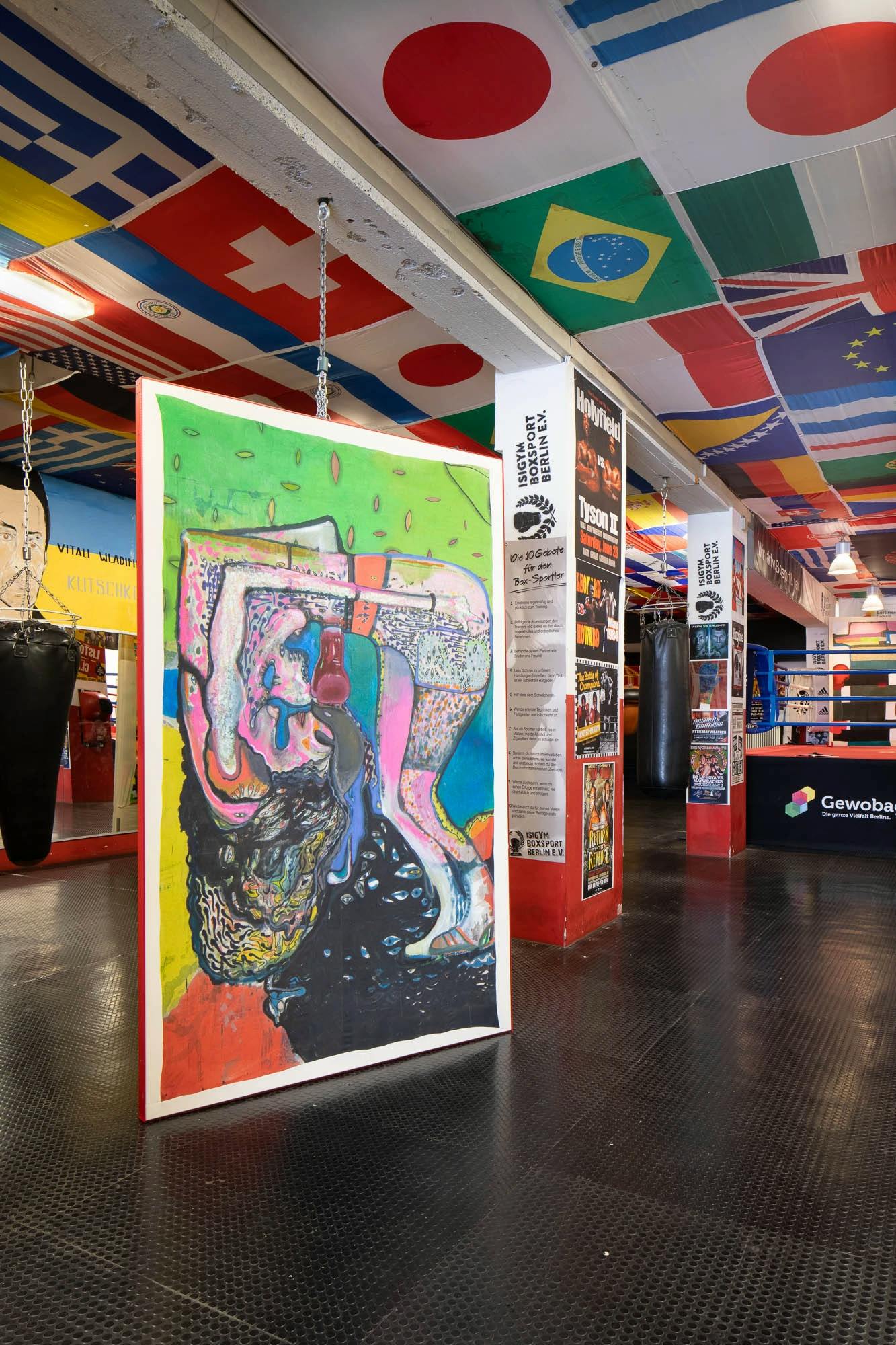The text was written in 2020 in response to a series of conversations with the Berlin based artist Bernhard Rappold.

Swing and a Miss, 250x160cm, Installation view of Jumpin' at Gleason's
Reading time 10'
How do you describe painting to an alien? Would you start the Martian off with some Leonardo Di Vinci? Or tell them about the Lascaux caves? Do you begin with the why, the what or, the how? Perhaps you quote a passage from an essay on painting? You think; scrap that idea, most writing on painting is boring.
The alien’s eyes are beaming, their antennas wriggling around.
Would you describe a painter’s studio, the smell of turpentine and coagulated paint, the stacked canvases and airless atmosphere; freighted with creative anticipation? Would you talk about the weeks turning into months turning into years?
You show the alien Bernhard Rappold’s paintings and their eyes light up, crinkling their forehead. They arch their neck to take a closer look. The canvas dwarfs their slender form, and they shuffle excitedly. Rapt in attention.
You run your hands over the surface of one of Rappold’s paintings and mention that they are brimful of figures with boneless jelly-like anatomy that are pushed up against the edges of the canvas. The characters — depictions of boxers mainly — seem to be decanted as much as painted. With legs in places they shouldn't be and arms akimbo, they seem committed to improbable jujitsu.
The paintings depict masculine archetypes rather than specific subjects, eliding the heroic with the sardonic. With proliferating eyes and skin like blancmange, everything seems to be toppling over and spilling outwards. The characters have droopy dicks and dissolving bodies. These figures seem more liable to knock themselves out than wallop an opponent.
You point at your own body and the figure on the canvas and suggest that Rappold paints bodies like landscapes. His kneecaps look like hill tops, legs recall roads and the arms are like green meadows. You take the alien on a road trip through the painting, their eyes darting about like a car speeding around the countryside.
Everything in Rappold’s work seems to go somewhere else; huge sweeping lines interrupted by marks that lie debris-like, scattering our attention. In works such as Pantera/Colombia, 2020, the figure is partially obliterated by colourful patches sewn onto the surface that fragment the body further. The boxer looks like he’s just been landed a sucker punch. You’re reminded of trying to watch TV as a kid, your favourite show interrupted by static.
Rappold’s imaginative appetite is ravenous. Cave painting, Egyptian hieroglyphics, Schiele, Hundertwasserand Munch come to mind. The twisted anatomy recalls pre-perspectival figure painting. Beyond the art historical canon, the paintings also invoke vernacular and folk culture such as batik and quilting. Household blankets made with old clothing and odds and ends. The surfaces of these paintings are glitchy and multi-hued: pink, lime green and cadmium red and their stained and splattered surfaces are sewn together. One can imagine the artist dancing around the studio sizing up the image like a prize boxer in the ring.
The alien is nodding in agreement. Painting; they now get, but boxing?
You show them the Akrotiri Boxer Fresco, 1700 BCE on your phone. Boxing, you say, has been around for thousands of years. As a sport, it was established to settle disputes and has evolved over centuries. It was practiced in the early Olympics in Ancient Greece and the Roman’s innovated their own bloody variety, often ending in the death to the defeated boxer.
You wonder whether the alien has seen an equivalent of boxing and painting in their own society.
They keep their mouth shut and look to the floor.
You mention to the alien that in ancient Egypt the dead were accompanied by relics and paintings that represented the deceased. The Egyptians had no word for art and much of their visual culture was only intended to be seen by gods. Painting often functioned as a bridge between life and the afterlife, and they believed that it became animate in darkness to accompany the soul after death. While the function of painting has moved from utility to self-expression perhaps it still bridges the gap between life and death. Maybe the canvas is like a coffin, awaiting the curiosity of future viewers to animate it in the artist's afterlife. The purpose of painting has changed over the centuries but ultimately it’s always been a place to bridge the space between the living and the dead, between the actual and the imagined.
The alien’s curiosity seems satiated. You sense that they finally understand the human need to re-make the world by imagining a different one.
Images painted on caves, symbols carved into stone. Tattoos on skin. Words written in sand. Painting remains a resilient technology. Humans have a deep need to make images and tell stories that exist beyond words. Rappold’s work belongs to these deep histories and remains utterly of the moment. He is artist as a clairvoyant; convening with the dead and the not yet born. The alien nods their head and seems entertained.